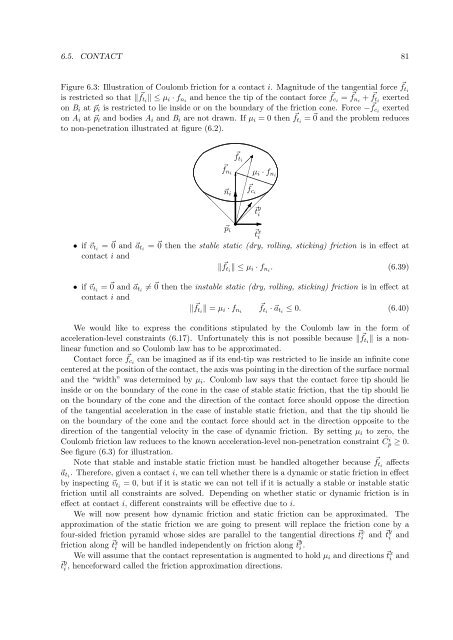thesis - Computer Graphics Group - Charles University - Univerzita ...
thesis - Computer Graphics Group - Charles University - Univerzita ...
thesis - Computer Graphics Group - Charles University - Univerzita ...
Create successful ePaper yourself
Turn your PDF publications into a flip-book with our unique Google optimized e-Paper software.
6.5. CONTACT 81<br />
Figure 6.3: Illustration of Coulomb friction for a contact i. Magnitude of the tangential force fti<br />
is restricted so that fti ≤ µi · fni and hence the tip of the contact force fci = fni + fti exerted<br />
on Bi at pi is restricted to lie inside or on the boundary of the friction cone. Force − fci exerted<br />
on Ai at pi and bodies Ai and Bi are not drawn. If µi = 0 then fti = 0 and the problem reduces<br />
to non-penetration illustrated at figure (6.2).<br />
❅❅<br />
❅<br />
❅<br />
❅<br />
<br />
fni<br />
✻<br />
ni<br />
✻<br />
✲<br />
pi t x ✓<br />
i<br />
✓✓✼<br />
✓ ✓✓✼ t y<br />
µi · fni<br />
i<br />
✒<br />
fti<br />
✄ ✄✄✄✄✄✄✄✄✗<br />
fci<br />
• if vti = 0 and ati = 0 then the stable static (dry, rolling, sticking) friction is in effect at<br />
contact i and<br />
fti ≤ µi · fni . (6.39)<br />
• if vti = 0 and ati = 0 then the instable static (dry, rolling, sticking) friction is in effect at<br />
contact i and<br />
fti = µi · fni<br />
fti · ati ≤ 0. (6.40)<br />
We would like to express the conditions stipulated by the Coulomb law in the form of<br />
acceleration-level constraints (6.17). Unfortunately this is not possible because fti is a nonlinear<br />
function and so Coulomb law has to be approximated.<br />
Contact force fci can be imagined as if its end-tip was restricted to lie inside an infinite cone<br />
centered at the position of the contact, the axis was pointing in the direction of the surface normal<br />
and the “width” was determined by µi. Coulomb law says that the contact force tip should lie<br />
inside or on the boundary of the cone in the case of stable static friction, that the tip should lie<br />
on the boundary of the cone and the direction of the contact force should oppose the direction<br />
of the tangential acceleration in the case of instable static friction, and that the tip should lie<br />
on the boundary of the cone and the contact force should act in the direction opposite to the<br />
direction of the tangential velocity in the case of dynamic friction. By setting µi to zero, the<br />
Coulomb friction law reduces to the known acceleration-level non-penetration constraint ¨ C i p ≥ 0.<br />
See figure (6.3) for illustration.<br />
Note that stable and instable static friction must be handled altogether because fti affects<br />
ati . Therefore, given a contact i, we can tell whether there is a dynamic or static friction in effect<br />
by inspecting vti = 0, but if it is static we can not tell if it is actually a stable or instable static<br />
friction until all constraints are solved. Depending on whether static or dynamic friction is in<br />
effect at contact i, different constraints will be effective due to i.<br />
We will now present how dynamic friction and static friction can be approximated. The<br />
approximation of the static friction we are going to present will replace the friction cone by a<br />
four-sided friction pyramid whose sides are parallel to the tangential directions t x i and t y<br />
i and<br />
friction along t x i will be handled independently on friction along t y<br />
i .<br />
t y<br />
i<br />
We will assume that the contact representation is augmented to hold µi and directions t x i and<br />
, henceforward called the friction approximation directions.
















